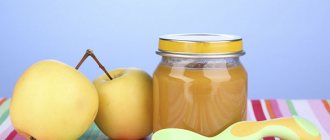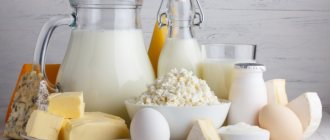Video on the topic
About the basic principles of introducing complementary foods into the diet of a 6-12 month old baby in the video:
The menu of a nine-month-old baby should be varied, healthy and nutritious. It is important to follow your diet. New vegetables, meat, fruits, and cereals should be introduced carefully, monitoring the body’s reaction and gradually increasing the portion.
In order for your child to like a product that is still unfamiliar to him, it is recommended to prepare a tasty and interesting dish from it. Before creating a regimen and diet, it is recommended to consult a pediatrician.
Potato and squash soup with turkey
Ingredients:
- potatoes – 6 pcs.
- turkey fillet – 300 gr
- zucchini – 2 pcs.
- salt to taste
- parsley, dill optional
Finely chop the turkey fillet and boil in salted water. While the turkey is simmering, chop the peeled zucchini and potatoes. Add potatoes first, then zucchini. Cook the soup covered over low heat until done.
It’s quite easy to learn how to cook delicious and unusual dishes from a limited list of products. Diversify the menu of your 9-month-old baby using new forms of preparing familiar products.
About the power mode
• A 9-month-old toddler has breakfast at 6 o’clock. By 11 o'clock he is ready to go back to bed. He sleeps twice in just one day.
• The number of meals is 5. The break between them is 4 hours.
• If the baby does not refuse to eat at night, it’s time to wean him off this habit. This is important not only for the mother’s peaceful sleep, but also for the baby’s digestion.
The body should not be overloaded with food. At night is the time to rest all systems. If the baby still wakes up at night, this does not mean that he is hungry.
It’s worth offering him something to drink and checking if he’s cold. Perhaps the apartment, on the contrary, is too stuffy, or the baby is dressed too warmly.
• By 9 months, it’s time to teach your baby to drink from a mug. He can handle this. Using sippy cups and bottles will create an additional habit that you will then have to wean off.
• There are WHO standards for the amount of food per day. But it is better to calculate individual indicators for the baby.
To do this, the child’s weight is divided by 9. For example, if a child weighs 9 kg, the norm is 1000 grams per day.
Tips for parents
- If the child does not want to take any product from the diet, you should not insist.
In this case, you can try to come up with other combinations of products that your baby may like. You can also take a break for 1-2 days and offer this product again. If your baby has a weak appetite or no appetite at all, you should reconsider his daily energy expenditure - physical activity, stay in the fresh air. Try to turn eating into an interesting activity, for example, imagine your child using a spoon as an airplane. - For a more varied menu, you can interchange products with similar properties, for example, use zucchini puree instead of broccoli puree. Another way is to serve food in different types and dishes. For example, meat can be prepared in the form of meatballs, soufflés from different varieties, or steamed cutlets.
Sample daily menu for a 9-month-old baby
| Feeding time | Product type | Volume |
| 6:00 | Formula/kefir or breast milk | 200 gr |
| 10:00 | Dairy/dairy-free porridge butter Fruit puree Half a yolk | 200 g (oil 5 g) 50 g |
| 14:00 | Vegetables in the form of puree with vegetable/butter Fish or meat soufflé/meatballs Bread | 200 g (oil 5 g) 50 g 5 g |
| 18:00 | Cottage cheese Fruit puree Cookies (biscuits, crackers) Formula/kefir or breast milk | 50 g 50 g 10 g (2 pcs.) 120 g |
| 22:00 | Formula/kefir or breast milk | 200 gr |
More on the topic: Helping your child lose weight: diet and exercise routine for losing excess weight
This table clearly displays a complete menu for a 9-month-old baby. Feeding according to the specified data will allow you to fully satisfy all the needs of a fragile body for nutrients, minerals, and vitamins.
Avoiding night feedings
Young parents, please note that at this age the child should no longer wake up for nighttime breastfeeding . Most newborns sleep peacefully throughout their sleep time and begin insistently demanding to be fed as soon as they open their eyes early in the morning. Typically, a 9-month-old baby's wake-up time is 6-7 am.
However, despite existing guidelines, some children of this age still wake up at night. If a child is rapidly gaining weight and is fully developing and does not suffer from poor appetite, night feedings should be avoided without fail. Before making hasty conclusions, you should consult your pediatrician about the norm for a child’s weight at 9 months, and compare your child’s parameters with the norm.
Normal weight of a newborn at 9 months
Below is a table of weight standards that was developed by the World Health Organization, where 1 is very high, 2 is high, 3 is above average, 4 is average, 5 is below average, 6 is low, 7 is very low.
Body weight indicators for boys
| 1 | 2 | 3 | 4 | 5 | 6 | 7 |
| 12,3 | 11,0 | 9,9 | 8,9 | 8,0 | 7,1 | 6,4 |
Girls' body weight indicators
| 1 | 2 | 3 | 4 | 5 | 6 | 7 |
| 12,0 | 10,5 | 9,3 | 8,2 | 7,3 | 6,5 | 5,8 |
Sample menu
For a baby who was fed only breast milk for up to six months:
- The first morning and fifth feedings are breast milk.
- The second meal is milk or dairy-free porridge with added butter and fruit puree. Porridge can be buckwheat, corn, oatmeal, rice, and occasionally semolina.
- The third feeding consists of vegetable and meat components. This can be vegetable puree with the addition of vegetable oil and yolk. Also on the menu are meat puree, juice and a slice of bread, preferably wheat. Also a good solution would be vegetable soup, to which you can add meat.
- The fourth feeding is fermented milk. For example, cottage cheese with fruit puree or pieces (if the fruit is soft), kefir or yogurt.
To diversify the menu during the week, it is enough to alternate porridges, a set of vegetables for soups and purees, add butter or vegetable oil. Instead of vegetable soup, give light meat broth and vegetable puree.
For a bottle-fed baby:
- Mixture.
- The second feeding is milk porridge with butter, half an yolk, juice or fruit puree.
- The third meal is vegetable puree with vegetable oil, meat puree, juice and a slice of wheat bread.
- The fourth feeding is cottage cheese, fruit or juice, yogurt or kefir, cookies or crackers.
- Mix again at night.
Menu table for the week
Below is a menu table for a nine-month-old baby by the hour.
| Time | Monday | Tuesday | Wednesday | ||||
| 6.00 – early breakfast | Adapted mixture (up to 200 g) or children's kefir | ||||||
| 10.00 – late breakfast | Semolina porridge (150g), jelly (100g) | Mashed millet porridge (150g), jelly (100g) | Semolina porridge with crackers (150g), jelly (100g) | ||||
| 14.00 - lunch | Vegetable puree (100-150g), jelly (50-100g) | Mashed potatoes with meat or liver (150g), jelly or juice (100ml) | Ground meat (30g) with mashed potatoes (100g), apricot puree (50g) | ||||
| 18.00 – dinner | Porridge – 200g, apple mousse or pudding | ||||||
| 22.00 – late dinner | Adapted mixture (up to 200 g) or children's kefir | ||||||
| Time | Thursday | Friday | Saturday | Sunday | |||
| 6.00 – early breakfast | Adapted mixture (up to 200 g) or children's kefir | ||||||
| 10.00 – late breakfast | Puree rice porridge (150g), jelly (100g) | Semolina porridge with apples (150g), jelly (100g) | Mashed buckwheat porridge (150g), applesauce (50g) | Puree oatmeal (150g), compote (100ml) | |||
| 14.00 - lunch | Mashed potatoes seasoned with yolks (150g), jelly (100g) | Vegetable puree with meat (150g), Applesauce (50g) | Chicken broth (100g), mashed potatoes (100g), baked apple – 50g | Meat pudding - 40g with mashed potatoes - 100g, jelly -100g | |||
| 18.00 – dinner | Porridge – 200g, apple mousse or pudding | ||||||
| 22.00 – late dinner | Adapted mixture (up to 200 g) or children's kefir | ||||||
Solid food is a step towards adulthood
In the diet of children under 9 months, we find foods crushed in a blender so that the baby does not choke. The next step in feeding is the introduction of solid pieces. To begin with, let it be just a small number of small pieces in a pureed food.
Every day this amount can be increased, gradually coming to the point that you no longer puree the food, but cut it finely with a knife. Thus, the menu will become more adult and the process of introducing the child to the common table will begin faster.
Cottage cheese and kefir
Any fermented milk products are introduced gradually. Not all children are happy to consume kefir, so it is better to offer it when the child is hungry and less picky about food.
But kids eat cottage cheese with great appetite. Kefir is given starting from 20 grams, and gradually increased to 180-200 grams.
It is recommended to bring the cottage cheese to 50 grams. You should not give your baby more, even if he can eat more.
The famous doctor Komarovsky claims that fermented milk products are ideal for complementary feeding, as they are derivatives of milk.
Features of a child's nutrition at 9 months
The nutrition of a child at 9 months is increasingly approaching the nutrition of an adult. During this period, mother’s milk remains very important, but the baby’s menu becomes more and more varied.
- Essential foods in a child's diet
- What to feed
- Feeding mode
At this age, the child already drinks from a cup. Tries to eat on his own with a spoon.
Of course, he is not good at this, but he has already begun to master the first successful attempts to feed himself.
Essential foods in a child's diet
Since at this age the baby’s diet expands significantly, it is very important to monitor how the child feels after eating new food.
What foods does he prefer and what foods does he absolutely not want to eat?
By 9 months his diet should include:
- various vegetables, in the form of puree;
- porridge;
- cottage cheese and kefir;
- meat, minced or chopped in a blender;
- liver, it is better if it is chicken or beef;
- language;
- yolk;
- fruit puree or juice;
- cookie;
- crackers.
Naturally, not everything will be to the baby’s taste, but during this period the basic taste preferences are formed and it is important that the child gets used to basic foods at this stage.
You should never rush - all new products are given to the baby, starting with small portions, 1-2 teaspoons.
And only after the child has become completely accustomed to the new dish, within 7-10 days, can it be given in full.
It is also necessary to take into account that each product that the child has not yet tried is introduced into the diet no earlier than 7 days after the previous one.
Porridge
At this age, after preparing porridge, there is no longer a need to blend it in a blender.
The baby has 2-4 teeth, and he is already able to bite and try to chew with them.
Therefore, the porridge is boiled well, butter or milk is added.
To improve the taste, you can also add fruit or vegetable puree.
Meat
Boiled meat is a necessary product that a baby should consume every day.
It's better if it's rabbit, chicken or beef. These types of meat are most beneficial for children of this age.
It’s very good if the baby loves offal and language.
They contain a lot of iron, which is very important for a child, especially when he has low hemoglobin.
When cooking, there is no longer any need to puree the meat.
With the appearance of teeth, you can use minced meat and prepare meatballs and steamed cutlets.
You should not give your baby store-bought minced meat. After all, it is impossible to know exactly what and in what quantity is there. You need to prepare minced meat yourself and only from high-quality, fresh meat.
The store offers many types of meat puree, prepared specifically for children of different ages.
Mashed potatoes in jars are a quality product, but you should not abuse them. This is more of a food for use in rare cases when the baby needs to be fed somewhere outside the home or the mother does not have time to prepare dinner.
Fish
Low-fat white fish varieties are a very healthy product. It's good if it's flounder or hake.
Sea fish contain iodine, which is also beneficial for children. Give it 1-2 times a week in boiled form. You can also make fish cutlets or meatballs.
Oil
The use of butter and vegetable oils is very important for the harmonious development of the baby.
Indeed, in addition to vitamins and minerals, they contain fatty acids, which are very useful for a growing organism.
The best vegetable oils are: olive, sesame and flaxseed. Butter is added to the porridge at the rate of 1 teaspoon per serving.
Cottage cheese and kefir
Any fermented milk products are introduced gradually. Not all children are happy to consume kefir, so it is better to offer it when the child is hungry and less picky about food.
But kids eat cottage cheese with great appetite. Kefir is given starting from 20 grams, and gradually increased to 180-200 grams.
It is recommended to bring the cottage cheese to 50 grams. You should not give your baby more, even if he can eat more.
The famous doctor Komarovsky claims that fermented milk products are ideal for complementary feeding, as they are derivatives of milk.
Cookies, bread
At this age, your baby can already be given biscuits. It is quite dense and contains a minimum of fat and sugar.
Cookies are given several times a day. Since the gums become very itchy as teeth grow, he will not only soothe the itching, but also learn to use his teeth.
Considering that the baby will try to bite off a piece, you should be especially careful and do not leave him alone for a minute while eating.
Instead of cookies, the baby is also offered crackers, carefully dried by the mother in the oven.
Yolk
Chicken yolk is given boiled. It can be added to porridge, soup, vegetable puree. It all depends on the child's preferences.
What to feed
By 9 months, the child eats 5 times a day. The first and last feeding is still breast milk or formula.
If the child develops normally, then nutrition during breastfeeding is not much different from artificial nutrition.
The only difference is still that with breastfeeding, the baby receives mother’s milk in the morning and at night, and with artificial feeding, formula.
If the baby has a good appetite and a normal weight for his age, then you should try to wean him from feeding at night. At 9 months, the child should already sleep through the night without waking up.
There is no need to adhere to a “template” regime designed one for everyone. After all, every child is individual.
Knowing her baby what time he wakes up and goes to bed, the mother independently determines the diet.
It is best if it is 5 feedings a day at regular intervals, for example 4 hours.
It should be taken into account that a baby eats approximately 1/9 of his weight in food per day. This amount is optimal for a child. With less food, he may starve; with more, he may gain excess weight.
Feed the baby freshly prepared food. Do not add salt or sweeten the dish.
The products contain enough salt and taste for the baby to take complementary foods with pleasure.
Useful tips for mothers: NUTRITION BY MONTH
It is very good if the house has a multicooker with a double boiler function, this will be a tangible power for the young mother. After all, you need to cook little by little, but often.
Feeding mode
Considering that at 9 months the baby is fed 5 times, 2 of which are mother’s milk or formula, then complementary foods are given 3 times.
Porridge is a more filling product, so a feeding interval of 4 hours is quite justified.
Breakfast
After waking up, the baby is offered breast milk. If the baby is bottle-fed, then he has formula milk for breakfast.
The mother must remember that breast milk, even at this stage, is very important for the normal development of the baby.
Lunch
The best option is porridge. The most valuable is buckwheat. It can be given to your child up to three times a week.
In addition, oatmeal is very healthy. It will be great if your child loves corn porridge.
But with rice, you need to be careful. It is necessary to monitor the baby's stool. If it negatively affects digestion, then it is better to give up rice for a while.
Dinner
Soup in low-fat broth with pureed meat or meatballs will be very useful at this time. It is also possible to have vegetable puree with a cutlet or meatball made from meat or offal.
Once or twice a week, the baby should eat fish balls instead of meat.
At this time, the child gets used to a varied menu, and in order to maintain the baby’s health in normal condition, it must be prepared correctly.
Dinner
At this time of day, you do not need to give your baby too nutritious food. For dinner, cottage cheese and fruit puree are best.
You can also give kefir and cookies.
After eating, you should not be very active. After all, if the baby has a lot of emotions at the end of the day, then there can be no talk of a restful sleep.
Second dinner
Before going to bed, the baby receives breast milk or, in the absence of it, formula milk.
Table of an approximate menu for a child at 9 months
The table shows food options for your baby for a week. Taking the recommendations as a basis, the mother can make her own adjustments and change the components, depending on the child’s preferences.
You can replace: jelly with juice, milk with mixture, or one porridge with another.
The main thing is to adhere to the basic nutritional rules:
- The first and last food of breastfeeding or mixture.
- Meat or fish for lunch.
- Cottage cheese or kefir for dinner.
- about the author
- Recent publications
Svetlana Ovechkina
author of the publication (site editor)
TEACHER Higher pedagogical education. Director of the kindergarten.
Svetlana Ovechkina recently published (see all)
- 7 month old baby’s daily routine – 03/28/2019
- Chocolate during breastfeeding - 03/25/2019
- How to resume breastfeeding - 03/21/2019











